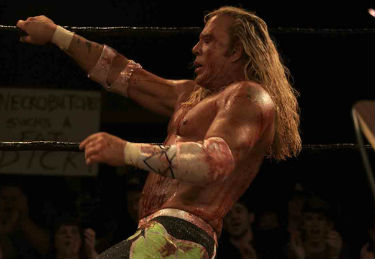Cinematic Identities... GENRES The horror and
The horror and
the comedy of genres
|
The genre picture is alive and kicking, says Ronald Bergan. But what are the finest examples, in and out of the system?
A survivor from a previous era ... Mickey Rourke in boxing drama The Wrestler While the winner of the Golden Lion in Venice, The Wrestler, was winning in other ways, and Mickey Rourke's performance as the ageing, washed-up pro wrestler of the title was excellent - he seemed to be drawing on a lifetime of experience - Darren Aronofsky's film hardly breaks any new ground, being rather too reminiscent of boxing movies like The Champ, The Set-Up and Fat City. But, familiarity seems to breed content with most audiences. Otherwise, how can one explain the everlastingly successful formula of sex, violence and campy humour in the James Bond movies which has remained virtually unchanged for over 40 years? The concept of the genre film really began during the Hollywood studio era. It helped production decisions and made a film easier to market. Also, during the so-called "golden era" - the 1930s and 1940s - when the studios were turning out hundreds of films at a rapid rate, the generic concept provided script writers with a template on which to work. Hollywood wasn't called the "Dream Factory" for nothing. Originality was frowned on, and mavericks like Orson Welles discouraged. Each studio specialized in a particular genre: Universal (horror), Warner Bros. (gangster), MGM (musical) and Paramount (comedy). Some directors became associated with a specific genre: John Ford (westerns), Cecil B. DeMille (epics), Alfred Hitchcock (thrillers), Vincent Minnelli (musicals) and Douglas Sirk (melodramas). But it was with the stars that the public most associated certain types of pictures. James Cagney, Edward G. Robinson (gangsters), Joan Crawford, Barbara Stanwyck (melodrama), Fred Astaire, Betty Grable (musicals), John Wayne, Randolph Scott (westerns) and Boris Karloff, Bela Lugosi (horror). Performers became so closely linked with certain genres that it became an event when |
they departed from the norm. "Garbo laughs!" was the publicity for Ernst Lubitsch's Ninotchka (1939), which prepared audiences to accept the mournful Swedish star, previously seen in melodramas, in a comedy. (Recently, another genre boxing movie, Million Dollar Baby, could have used the tag line, "Clint Eastwood cries!"). Today, genres and actors have become more flexible, though stars like Bruce Willis and Sylvester Stallone remain associated with action movies, and Jim Carrey and Adam Sandler with comedies. There are still directors who specialize in certain genres: Tim Burton with fantasy, John Woo with action, Wes Craven with horror. When going to a movie to which the names above are attached, audiences already have certain preconceptions and expectations of what kind of film it will be. The public is also familiar enough with genres to enjoy lampoons, such as Mel Brooks' Blazing Saddles and the Austin Powers movies of the late 1990s. Yet, even though, over the years, traditional genres have been reinterpreted, revisionized, challenged or satirized, the genre film is extant but with all the well-loved conventions now well-worn cliches. As always, if one wants to seek out originality, even desperately for its own sake, as I do, one must look beyond genres. Thankfully, among the mimetic films in the official competition of 21 films - four films attempted to extend the language of cinema: Patrick Mario Bernard and Pierre Trividic's L'Autre, with a strange William Wilsonian story of a woman jealous of her doppelganger; Semih Kaplanoglu's Milk, another fine Turkish movie, with an inventive sense of narrative, which moves easily between the realistic and surrealistic, from the sequential to the episodic; Alexei German Jr's Paper Soldier, a fascinating absurdist drama - the antithesis of The Right Stuff - which narrates (backwards) the days before and after Yuri Gargarin's space flight; and Tariq Teguila's Gabbla (Inland), an Algerian film, that shows lonely figures in an unfriendly landscape, where silence is eloquent, while making a poignant non-didactic political statement about the desperate migration of people from third world countries. All this proved that there are still a minority of directors making films that don't immediately remind one of better ones on the same subject and in the same style. Ronald BERGAN |


